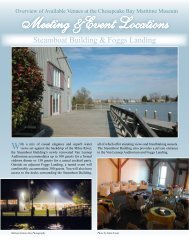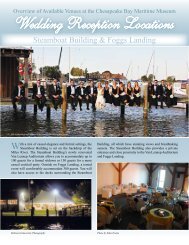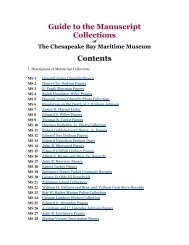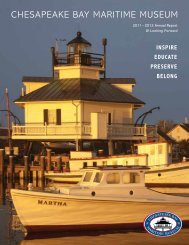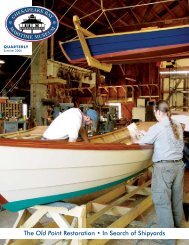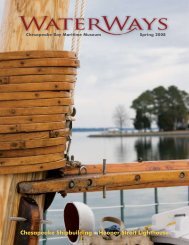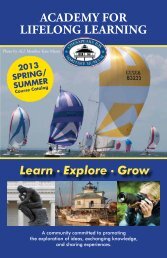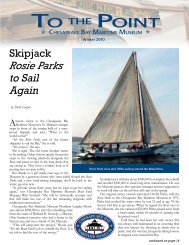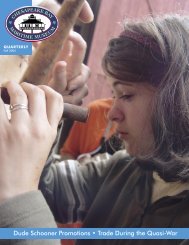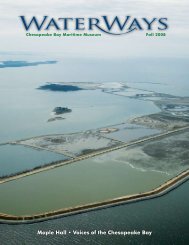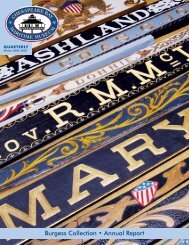Spring 2003 - Chesapeake Bay Maritime Museum
Spring 2003 - Chesapeake Bay Maritime Museum
Spring 2003 - Chesapeake Bay Maritime Museum
You also want an ePaper? Increase the reach of your titles
YUMPU automatically turns print PDFs into web optimized ePapers that Google loves.
QUARTERLY<br />
<strong>Spring</strong> <strong>2003</strong><br />
This Issue: Runaway Slaves • A British Invasion
President’s Message<br />
QUARTERLY<br />
<strong>Spring</strong> <strong>2003</strong><br />
Volume 1 Number 1<br />
Editor<br />
Michael Valliant<br />
Graphic Designers<br />
Laura Vlahovich, Phil Jones<br />
Contributors<br />
Cathy Connelly, Julie Cox,<br />
Leigh Ann Gay, Pete Lesher,<br />
Otto Loggers, Melissa McLoud,<br />
Kristi Mertaugh, John Miller,<br />
Meagan Shaw, Bill Thompson,<br />
Mike Vlahovich<br />
Photography<br />
Bill Thompson, Laura Vlahovich,<br />
Phil Jones<br />
Illustrations<br />
Eric T. Applegarth<br />
<strong>Chesapeake</strong> <strong>Bay</strong> <strong>Maritime</strong> <strong>Museum</strong><br />
Navy Point, P.O. Box 636<br />
St. Michaels, MD 21663-0636<br />
410-745-2916 • Fax 410-745-6088<br />
www.cbmm.org • editor@cbmm.org<br />
The <strong>Chesapeake</strong> <strong>Bay</strong> <strong>Maritime</strong> <strong>Museum</strong> is a private<br />
not-for-profit 501(c)(3) educational institution. A<br />
copy of the current financial statement is available on<br />
request by writing the Controller, P.O. Box 636, St.<br />
Michaels, MD 21663 or by calling 410-745-2916 ext.<br />
124. Documents and information submitted under<br />
the Maryland Charitable Solicitations Act are also<br />
available, for the cost of postage and copies, from the<br />
Maryland Secretary of State, State House, Annapolis,<br />
MD 21401, 410-974-5534.<br />
On the Cover<br />
Interim Boat Yard Manager MikeVlahovich<br />
and apprentice Heron Schwalbach-Scott<br />
work on one of the rowing skiffs being<br />
created through the Apprentice for a Day<br />
program. The wooden vessels are built by<br />
weekend apprentices under the guidance of<br />
master shipwrights. Anyone can become an<br />
Apprentice for a Day and the skiffs are for<br />
sale with proceeds helping to sustain the<br />
program. For more information, contact<br />
Mike Vlahovich at 410-745-2916 ext. 186<br />
or e-mail mvlahovich@cbmm.org.<br />
Enclosed please find Navy Point.<br />
At least that’s the idea behind our new<br />
magazine. We are sending the activity and<br />
excitement of the <strong>Museum</strong>’s campus to our<br />
members across the country. Our publications<br />
enable us to broadcast the ongoing stories,<br />
news, and events that define the <strong>Chesapeake</strong> <strong>Bay</strong><br />
<strong>Maritime</strong> <strong>Museum</strong>.<br />
This publication represents a new direction<br />
for the <strong>Museum</strong>: one that combines the news,<br />
programs, and calendar of our quarterly newsletter<br />
On the Beam with feature articles and scholarship of the semi-annual The Weather<br />
Gauge. The result is a quarterly publication that gives us a forum for communicating<br />
the breadth of the <strong>Museum</strong>’s mission and vision to our members and friends.<br />
This inaugural issue is sponsored by the <strong>Museum</strong>’s Volunteers’ Association.<br />
The generosity of our volunteers, both financially and in terms of service,<br />
cannot be easily measured. The Volunteers’ Association is closely tuned to<br />
the needs of the <strong>Museum</strong>. They made the first gift to our successful capital<br />
campaign. Our volunteers have helped equip the library and supplied our Boat<br />
Yard with tools. They renovated the Model Guild Shop and this past year; built<br />
a fully functional replica of a Smith Island crabbing skiff, fittingly christened<br />
Volunteer. Heartfelt thanks to our volunteers for helping the <strong>Museum</strong> launch its<br />
most comprehensive publication to date.<br />
In this issue, you will see how our Boat Yard garnered international acclaim<br />
by lending aid and expertise to the British vessel Irene, dismasted by a severe<br />
Atlantic storm. You will learn why the <strong>Chesapeake</strong> <strong>Bay</strong> was a refuge for<br />
African-American slaves seeking freedom. You will find our program calendar<br />
for spring and early summer, which you can pull out for your convenience.<br />
And we’ll bring you the news around campus: from the <strong>Museum</strong> acquiring the<br />
world’s largest collection of oyster cans, to seeing plans for the new recreation<br />
exhibit building, to a staff profile of Vice President of Finance Ann Rybon, who<br />
recently became the first <strong>Museum</strong> employee to serve twenty-five years on staff.<br />
Each issue will sign off with a guest columnist sharing stories or reflections<br />
about his or her personal connection with the <strong>Bay</strong>. Our first writer is J. Taylor<br />
Buckley, long-time editor for USA Today, who recently retired to his Eastern<br />
Shore farm. Mr. Buckley tells a witty and compelling personal story about<br />
his fascination with sinkboxes, an improbable but true tale that connects<br />
waterfowling on the <strong>Chesapeake</strong> with a flea market on the outskirts of Paris.<br />
With this first edition of our magazine, we move forward in providing our<br />
members with stories and articles about the extraordinarily rich and diverse<br />
heritage of the <strong>Chesapeake</strong> <strong>Bay</strong>. But we only do this if we strike a chord with<br />
our members. You are our best critics and we value your opinions the most.<br />
Please let us know what you think.<br />
John R. Valliant<br />
President<br />
jvalliant@cbmm.org<br />
<strong>Chesapeake</strong> <strong>Bay</strong> <strong>Maritime</strong> <strong>Museum</strong> • <strong>Spring</strong> <strong>2003</strong>
Features<br />
In the Can<br />
Though few <strong>Chesapeake</strong> oyster packing plants remain in operation,<br />
there is no shortage of oyster cans at the <strong>Museum</strong>.<br />
By Bill Thompson<br />
Recreation Exhibit Plans<br />
Plans for the new recreation exhibit building reveal a structure that has<br />
been designed from the inside out.<br />
“Bred up to the Water”<br />
A historical look at how runaway slaves employed the <strong>Chesapeake</strong> <strong>Bay</strong><br />
as a waterway to freedom.<br />
By Benjamin H. Trask<br />
Earl Grey & Old <strong>Bay</strong><br />
3<br />
6<br />
11<br />
After a harrowing run-in with a violent storm at sea, a battered British<br />
vessel seeks refuge and repairs at Navy Point.<br />
By Bill Thompson<br />
“It Came from France”<br />
17<br />
22<br />
A long-time USA Today editor reflects on <strong>Chesapeake</strong> <strong>Bay</strong> sinkboxes.<br />
By J. Taylor Buckley<br />
Under the experienced hands of British<br />
shipwrights John Habgood (above) and<br />
Adrian Grigg and with help from <strong>Museum</strong><br />
apprentices, a new mast for the<br />
storm-damaged Irene emerges from a<br />
log of Douglas fir.<br />
Departments<br />
Breene M. Kerr Center<br />
for <strong>Chesapeake</strong> Studies<br />
From the Boat Yard<br />
Volunteers<br />
Advancement<br />
Events Calendar *<br />
Profile<br />
5<br />
7<br />
8<br />
9<br />
11A<br />
21<br />
* Events Calendar is a special pull-out<br />
section that can be found between<br />
pages 11 and 12.<br />
Contents<br />
2
<strong>Museum</strong> Acquires World’s Largest Collection of Oyster Cans • By Bill Thompson<br />
In the Can
When it comes to epiphanies, the one that struck Ronnie<br />
Newcomb back in the early 1970s was little more than the<br />
garden variety. A part-time collector of <strong>Chesapeake</strong> <strong>Bay</strong><br />
hunting decoys and other tidewater memorabilia, Newcomb<br />
was on the prowl when some empty oyster cans—the kind that<br />
usually ended up in the garbage—caught his eye.<br />
“Through my decoy collecting and travels, I started<br />
noticing the oyster tins with their really nice colorful labels,”<br />
he said. “It was funny to me, all these same oysters were going<br />
into so many different cans with different labels.”<br />
He picked up a can here and a can there and, like the<br />
children’s story of the old couple who could not resist adopting<br />
every cat they saw, Newcomb eventually amassed what turned<br />
out to be the largest and most valuable collection of its kind.<br />
Late last summer the <strong>Museum</strong> acquired Newcomb’s 592<br />
oyster containers as well as an assortment of 300 other oysterrelated<br />
artifacts ranging from thimbles to large advertising<br />
signs. The earliest of the tins date to the 1880s and one<br />
container still holds the oysters originally hand-packed on the<br />
assembly line. Most cans are gallon-sized, while some have<br />
eight-ounce capacities and others held five gallons of the soft<br />
and salty mollusk.<br />
The value of the collection has been appraised at more<br />
than $200,000. But aside from the monetary worth and the<br />
<strong>Museum</strong>’s bragging rights of having more oyster cans than<br />
anyone else, the significance of the collection lies in what it<br />
says about the history of the <strong>Chesapeake</strong> <strong>Bay</strong>’s once dominant<br />
seafood industry.<br />
“The importance of this collection to the <strong>Chesapeake</strong> <strong>Bay</strong><br />
<strong>Maritime</strong> <strong>Museum</strong> is hard to overstate,” said <strong>Museum</strong> Curator<br />
Pete Lesher. “These artifacts are a key to a number of projected<br />
exhibits and Kerr Center for <strong>Chesapeake</strong> Studies research<br />
projects that will be ultimately transformed into various sorts<br />
of public programming. This collection will be invaluable to<br />
historians looking for clues to the existence, location, products,<br />
and dates of operations of early business enterprises.”<br />
Former Kerr Center scholars Dr. Virginia Jenkins and Paul<br />
Touart have already documented the business and marketing<br />
history of Maryland’s Eastern Shore seafood companies. And<br />
current scholar Harold Anderson is researching the role of<br />
African Americans in the seafood packing business. <strong>Museum</strong><br />
officials believe the new oyster can collection is an invaluable<br />
addition to the continued study of tidewater history.<br />
<strong>Museum</strong> President John Valliant, whose great-grandfather<br />
once owned a canning plant in Talbot County, said he hopes<br />
that the public will have an opportunity to see the collection.<br />
In the meantime, individual cans may be used to refresh the<br />
smaller collection in the Oystering on the <strong>Chesapeake</strong> exhibit.<br />
Like the cans themselves, there were so many oyster<br />
packing houses along the shores of the <strong>Chesapeake</strong> at one<br />
time that their role in the daily economic and cultural lives<br />
of tidewater residents was taken for granted. In fact, the<br />
<strong>Museum</strong>’s Navy Point campus once was the site of several<br />
oyster packing plants. Today few oyster packing buildings<br />
have survived the pressures of a changing economy. They are<br />
gone or vacant or converted to some other use.<br />
Thanks to Ronnie Newcomb’s eye for colorful labels, a<br />
unique treasure of oyster cans has survived. •<br />
(Opposite page) <strong>Museum</strong> Curator Pete Lesher and President John R.<br />
Valliant stand amidst a sea of oyster cans. The acquisition of nearly<br />
600 cans, along with scores of rare labels and unusual marketing<br />
materials (above), represents the largest collection of its kind.<br />
In the Can 4



